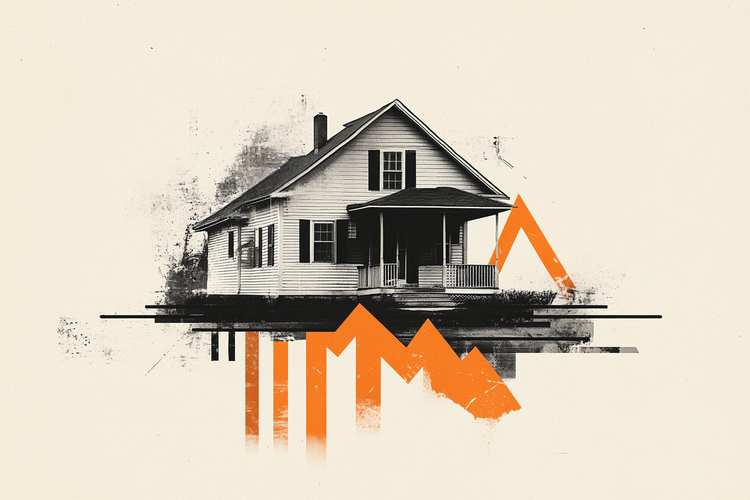The US housing market is going through a critical phase, marked by falling demand, rising interest rates and lasting structural tensions. Long buoyed by a post-pandemic boom, the market is now facing an unprecedented combination of headwinds.
For homeowners, the golden years are coming to an end, and for potential buyers, the challenges remain numerous despite a relative lull in prices.
The end of a euphoric cycle
During the COVID-19 pandemic, millions of Americans took advantage of historically low mortgage rates, often below 3%, to buy homes in fast-growing areas such as Austin, Miami and Atlanta.
At the time, the urban exodus, the spread of telecommuting and the search for space had led to a spectacular surge in prices.
Those who bought at that time still benefit today from advantageous interest rates, protecting them from some of today’s turbulence.
But the picture has changed radically. With the Federal Reserve’s (Fed) restrictive monetary policy to combat inflation, interest rates have soared, the average 30-year rate now hovering between 6.5% and 7%, compared with less than 3% three years ago.
As a result, home ownership has become much more expensive, and demand has contracted sharply.
An unbalanced market: Between scarcity and excess
The US real estate market presents a striking paradox. On the one hand, the supply of existing homes remains historically low.
According to AInvest, approximately 80% of homeowners still hold mortgages with interest rates below 6%, which is encouraging them not to sell. This phenomenon, known as the “lock-in effect”, limits supply on the resale market.
On the other hand, the supply of new homes is surging in certain regions such as Florida and Texas, where construction boomed during the pandemic.
Today, it is these markets that are suffering the most. The inventory of new homes has reached record levels (over 500,000 units on sale in June, according to the Census Bureau), and developers have no choice but to lower prices or offer financial incentives to buyers to clear their inventories.
The median price of a new home is now lower than that of an existing property, a situation that has only been observed six times in 26 years, according to Newsweek. This reflects a real inflection point in the market.
Prices are down, but not everywhere
Price adjustments are not uniform. In the South and West of the country, regions that had outperformed between 2020 and 2022, the corrections are the most severe. In Miami, prices have fallen by almost 19% since their peak. Austin, San Antonio, Dallas and even Denver are experiencing double-digit declines, according to Work and Money.
Conversely, the Northeast and Midwest are holding up better. In Milwaukee, prices have even risen by more than 25% since 2022, thanks to a persistent housing shortage, reported Work and Money.
These regional disparities underline the fact that market dynamics are deeply local, and that national averages often mask contrasting realities.
The impact of interest rates and public policies
Interest rates continue to play a central role. While the Fed is considering its first rate cut of the year in September, markets remain cautious.
Indeed, long-term mortgage rates are more closely linked to 10-year Bond yields, which remain high. Thus, even an easing of monetary policy would not guarantee a rapid easing of borrowing conditions for buyers.
At the same time, the tariffs imposed by US President Donald Trump on building materials such as steel and wood have pushed up costs, penalizing developers.
And rising insurance premiums, particularly in Florida, where they exceed $11,000 a year versus $2,400 nationwide, according to the Economist, are another disincentive to buying and building, especially in areas prone to weather-related disasters.
A market that worries the Fed
At its meeting at the end of July, the Federal Reserve clearly expressed its concerns about the health of the housing market.
Falling residential investment, increasing sales delays, rising numbers of unsold homes and stagnant prices are now weighing on the overall economic outlook.
Housing, traditionally one of the most interest-rate-sensitive sectors, also serves as a leading indicator of the direction of the economy.
Towards stabilization or a deeper correction?
A number of signs suggest that prices may continue to fall in the short term, especially in regions where supply remains abundant.
The rate of purchase withdrawals (over 15% in July, according to Redfin) is reaching record levels, signalling increased buyer reluctance. Yet the risk of a widespread collapse remains limited.
The majority of homeowners are in a strong position. They hold cheap loans, have seen the value of their property rise by almost 50% since the pre-COVID period, and are under no immediate financial pressure, notes TCD.
A market in flux, but not in crisis
The US real estate market is at a crossroads. It’s not a collapse, but a recomposition. Prices are gradually falling, supply and demand are realigning, and sellers and buyers alike need to adapt to a new, more constrained environment.
For investors and private individuals alike, this new reality calls for a more nuanced approach.
Vigilance in overheating regions, increased interest in under-supplied markets, and anticipation of future movements in interest rates.
In this uncertain environment, information, strategy and patience are the keys to navigating this housing market in transition.
Read the full article here


